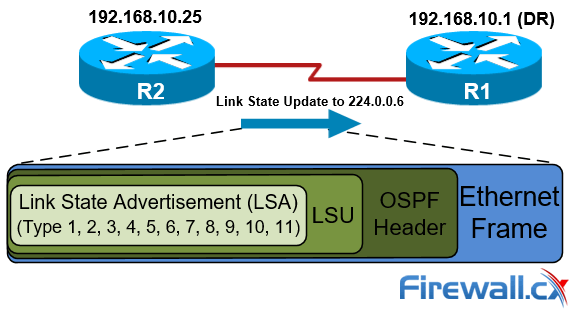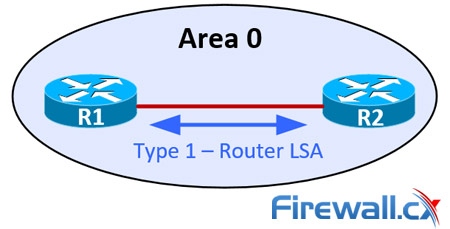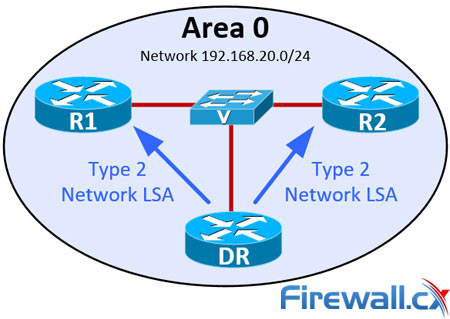OSPF - Part 6: OSPF LSA Types - Purpose and Function of Every OSPF LSA
Our previous article explained the purpose of Link State Update (LSU) packets and examined the Link State Advertisement (LSA) information contained within LSU packets. We also saw the most common LSA packets found in OSPF networks. In this article we’ll be diving deeper to analyse all eleven OSPF LSA Types using network network diagrams and examples to help understand when each LSA type is used and how they keep the OSPF network updated.
LSA Types - Quick Overview
Before we begin, let’s take a quick look at the different type of OSPF LSA packets we’ll cover:
- LSA Type 1: OSPF Router LSA
- LSA Type 2: OSPF Network LSA
- LSA Type 3: OSPF Summary LSA
- LSA Type 4: OSPF ASBR Summary LSA
- LSA Type 5: OSPF ASBR External LSA
- LSA Type 6: OSPF Group Membership LSA
- LSA Type 7: OSPF Not So Stubby Area (NSSA) External LSA
- LSA Type 8: OSPF External Attributes LSA (OSPFv2) / Link Local LSA (OSPFv3)
- LSA Type 9: OSPF Link Scope Opaque (OSPFv2) / Intra Area Prefix LSA (OSPFv3)
- LSA Type 10: OSPF Area Scope Opaque LSA
- LSA Type 11:OSPF AS (Autonomous System) Scope Opaque LSA
Below is a complete list of articles covering our OSPF Series:
The LSA payload varies in size according to the LSA type and the information it includes. The diagram below clearly shows how LSAs are contained within LSUs:

Figure 1. LSA Types contained within an OSPF LSU packet
As mentioned, OSPF currently supports 11 types of LSAs. Each LSA is used within specific boundaries of an OSPF network.
OSPF concepts, including router roles such as Designated Router (DR), Area Border Router (ABR), Autonomous System Border Router (ASBR), OSPF Areas and more, are analyzed in great depth in our article OSPF Basic Concepts – OSPF Areas – Router Roles. This article assumes the reader has a good understanding of basic OSPF theory and is comfortable with OSPF concepts.
LSA Type 1 – OSPF Router LSA
LSA Type 1 (Router LSA) packets are sent between routers within the same area of origin and do not leave the area. An OSPF router uses LSA Type 1 packets to describe its own interfaces but also carries information about its neighbors to adjacent routers in the same area.

Figure 2. LSA Type 1 Packets exchanged between OSPF routers within the same area
LSA Type 2 – OSPF Network LSA
LSA Type 2 (Network LSA) packets are generated by the Designated Router (DR) to describe all routers connected to its segment directly. LSA Type 2 packets are flooded between neighbors in the same area of origin and remain within that area.

Figure 3. LSA Type 2 Packets exchanged between OSPF DR and neighbor routers
LSA Type 3 – OSPF Summary LSA
LSA Type 3 (Summary LSA) packets are generated by Area Border Routers (ABR) to summarize its directly connected area, and advertise inter-area router information to other areas the ABR is connected to, with the use of a summary prefix (e.g 192.168.0.0/22). LSA Type 3 packets are flooded to multiple areas throughout the network and help with OSPF’s scalability with the use of summary prefixes.

Figure 4. LSA Type 3 - An OSPF ABR router advertises the summarized route 192.168.2.0/24 to Area 0
Looking at the diagram above, ABR router R2 creates a Type 3 Summary LSA and floods it into Area 0. In a similar way, ABR router R3 creates a Type 3 Summary LSA and floods it into Area 2. Type 3 Summary LSAs appear as O IA entries in the router routing table.
LSA Type 4 – OSPF ASBR Summary LSA
LSA Type 4 (ASBR Summary LSA) packets are the LSAs that advertise the presence of an Autonomous System Border Router (ASBR) to other areas. In the example below when R2 (ABR) receives the LSA Type 1 packet from R1 it will create a LSA Type 4 (Summary ASBR LSA) packet, which advertises the ASBR route received from Area 1, and inject it into Area 0.

Figure 5. LSA Type 4 packets injected into Area 0 & 2 by the R2 ABR and R3 ABR
While LSA Type 4 packets are used by ABRs to advertise the ASBR route through their areas, it will not be used by the ASBR itself within its local area (Area 1); ASBR uses LSA Type 1 to inform its neighbors (R2 in this case) within its networks.
LSA Type 5 – OSPF ASBR External LSA
LSA Type 5 (ASBR External LSA) packets are generated by the ASBR to advertise external redistributed routes into the OSPF’s AS. A typical example of an LSA Type 5 would be an external prefix e.g 192.168.10.0/24 or default route (internet) as shown below:
 Figure 6. LSA Type 5 packets advertise the default route to all OSPF routers
Figure 6. LSA Type 5 packets advertise the default route to all OSPF routers
This external route/prefix is redistributed in to the OSPF network by the ASBR (R1) and seen as O E1 or E2 entries in other OSPF routers routing tables.
LSA Type 6 – OSPF Group Membership LSA
LSA Type 6 (Group Membership LSA) packets were designed for Multicast OSPF (MOSPF), a protocol that supports multicast routing through OSPF. MOSPF is not supported by Cisco and is not widely used and is expected to be retired soon.
LSA Type 7 – OSPF Not So Stubby Area (NSSA) External LSA
LSA Type 7 (NSSA External LSA) packets are used for some special area types that do not allow external distributed routes to go through and thus block LSA Type 5 packets from flooding through them, LSA Type 7 packets act as a mask for LSA Type 5 packets to allow them to move through these special areas and reach the ABR that is able to translate LSA Type 7 packets back to LSA Type 5 packets.

Figure 7. LSA Type 7 packets passing through an NSSA and being transformed into LSA Type 5 by the ABR
In the above example, ABR R2 translates LSA Type 7 into a LSA Type 5 and floods it into the OSPF network.
LSA Type 8 - OSPF External Attributes LSA (OSPFv2) / Link Local LSA (OSPFv3)
LSA Type 8 packets (External Attributes LSA -OSPFv2-/ Link Local LSA -OSPFv3-) in OSPFv2 (IPv4) are called External Attribute LSAs, and are used to transit BGP attributes through an OSPF network while BGP destinations are conveyed via LSA Type 5 packets, however, this feature isn’t supported by most routers. With OSPFv3 IPv6), LSA Type 8 is redefined to carry IPv6 information through OSPF network.
LSA Type 9, 10 & 11
Generally Opaque LSAs (LSA Type 9, 10 & 11) are used to extend the capabilities of OSPF allowing the protocol to carry information OSPF doesn’t necessarily care about. Practical application of Opaque LSAs is in MPLS traffic engineering where they are used to communicate interface parameters such as maximum bandwidth, unreserved bandwidth, etc. Following is a short analysis of each of the three Opaque LSAs.
LSA Type 9 – OSPF Link Scope Opaque (OSPFv2) / Intra Area Prefix LSA (OSPFv3)
LSA Type 9 in OSPFv2 (IPv4) is defined as a Link Scope Opaque LSA for carrying OSPF information. For OSPFv3 it’s redefined to handle a communication prefix for a special area type called Stub Area.
LSA Type 10 – OSPF Area Scope Opaque LSA
LSA Type 10 packets are used to flood OSPF information through other area routers even if these routers do not process this information in order to extend OSPF functionality, this LSA is used for traffic engineering to advertise MPLS and other protocols.
LSA Type 11 – OSPF AS Scope Opaque LSA
LSA Type 11 packets serve the same purpose as LSA Type 10 packets but are not flooded into special area types (Stub areas).
Summary
In this article we examined all 11 OSPF LSA packet types and explained their purposes. We also examined the structure of an LSA packet and used network diagrams to help illustrate how LSA packets flow between routers & OSPF Areas. For more high-quality OSPF articles visit our OSPF Section.
Wi-Fi Key Generator
Follow Firewall.cx
Cisco Password Crack
Decrypt Cisco Type-7 Passwords on the fly!



















